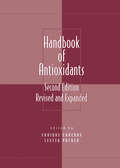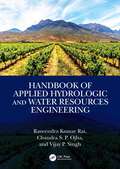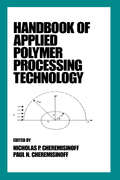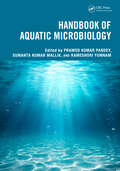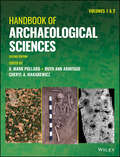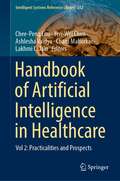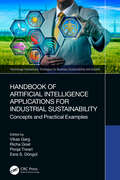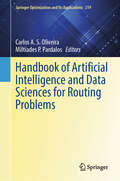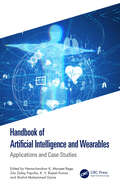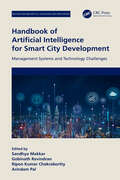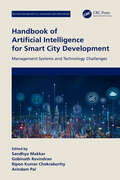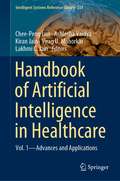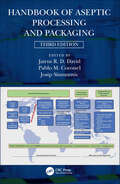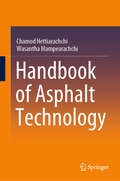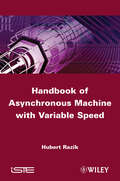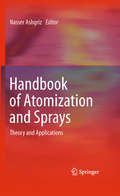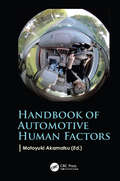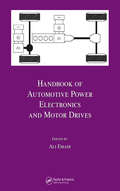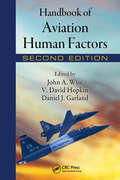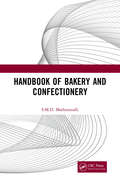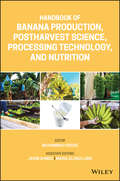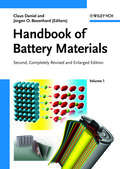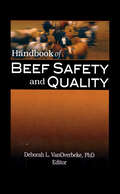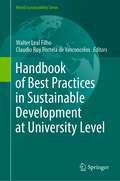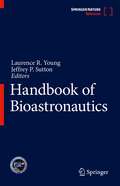- Table View
- List View
Handbook of Antioxidants (Oxidative Stress and Disease)
by Enrique Cadenas Lester PackerContains new and expanded material on antioxidants in beverages and herbal products, nitric oxide and selenium, and the effect of vitamin C on cardiovascular disease and of lipoic acid on aging, hyperglycemia, and insulin resistance! Offering over 4200 contemporary references-2000 more than the previous edition-the Second Edition of the Handbook of Antioxidants is an up-to-the-minute source for nutritionists and dietitians, cell biologists and biochemists, cardiologists, oncologists, dermatologists, and medical students in these disciplines.
Handbook of Applied Hydrologic and Water Resources Engineering
by Vijay P. Singh Raveendra Kumar Rai Chandra Shekhar OjhaThe Handbook of Applied Hydrologic and Water Resources Engineering examines the planning and design of water supply systems, flood control works, drought mitigation measures, navigation facilities, and hydraulic structures, as well as feasibility and environmental impact studies for various water-related projects. It is based on the experience gained through consultancy in dealing with various water resources issues and problems, teaching, and research. It serves as a useful resource for graduate students and faculty members in civil engineering, agricultural engineering, and water resources engineering, as well as practicing engineers working in civil, environmental, and agricultural fields.
Handbook of Applied Polymer Processing Technology (Plastics Engineering Ser. #31)
by Nicholas P. Cheremisinoff Paul N. Cheremisinoff"Offers detailed coverage of applied polymer processing--presenting a wide range of technologies and furnishing state-of-the-art data on polymer components, properties, and processibility. Reviews fundamental rheological concepts. Contains over 1600 bibliographic citations, some 450 equations, and over 400 tables, drawings, and photographs."
Handbook of Aquatic Microbiology
by Pramod Kumar Pandey, Sumanta Kumar Mallik, and Rameshori YumnamShort Blurb This handbook covers the different aspects of the aquatic environment, microbiology, and microbial applications. It highlights the role of microorganisms as pollution indicators and as bio-control agents. The book covers the impact of pollution on microorganisms, biofilms, cyanobacterial blooms, and the metagenomics approach to isolate microbes. Standard Blurb This comprehensive handbook covers the different aspects of the aquatic environment, microbiology, and microbial applications. The world’s aquatic environment is facing a serious threat due to inappropriate planning, implementation, and management. This book compiles effective strategies for managing the aquatic environment. It highlights the role of microorganisms as pollution indicators, in bioremediation, and as bio-control agents. The book also covers the impact of pollution on microorganisms, biofilms, cyanobacterial blooms, and the metagenomics approach to isolate microbes. This book is essential for students and researchers of microbiology, environmental sciences, and biotechnology Seasonal Blurb This comprehensive handbook covers the different aspects of the aquatic environment, microbiology, and microbial applications. The world’s aquatic environment is facing a serious threat due to inappropriate planning, implementation, and management. This book compiles effective strategies for managing the aquatic environment. It highlights the role of microorganisms as pollution indicators, in bioremediation, and as bio-control agents. The book also covers the impact of pollution on microorganisms, biofilms, cyanobacterial blooms, and the metagenomics approach to isolate microbes. This book is essential for students and researchers of Microbiology, Environmental Sciences, and Biotechnology. 1 Includes key themes like environmental DNA application, metagenomes, extremophiles, microbial population genetics and statistical aspects of aquatic microbiology 2 Discusses the beneficial microbes of the aquatic environment 3 Covers applications of microbes in bioremediation, as pollution indicators and as algicidal agents 4 Reviews freshwater biogeochemical cycles and sediment microbiology 5 Explores microbial communities of biofloc and microbiomes in aquaponics
Handbook of Archaeological Sciences
by Cheryl A. Makarewicz A. Mark Pollard Ruth Ann ArmitageHANDBOOK OF ARCHAEOLOGICAL SCIENCES A modern and comprehensive introduction to methods and techniques in archaeology In the newly revised Second Edition of the Handbook of Archaeological Sciences, a team of more than 100 researchers delivers a comprehensive and accessible overview of modern methods used in the archaeological sciences. The book covers all relevant approaches to obtaining and analyzing archaeological data, including dating methods, quaternary paleoenvironments, human bioarchaeology, biomolecular archaeology and archaeogenetics, resource exploitation, archaeological prospection, and assessing the decay and conservation of specimens. Overview chapters introduce readers to the relevance of each area, followed by contributions from leading experts that provide detailed technical knowledge and application examples. Readers will also find: A thorough introduction to human bioarchaeology, including hominin evolution and paleopathology The use of biomolecular analysis to characterize past environments Novel approaches to the analysis of archaeological materials that shed new light on early human lifestyles and societies In-depth explorations of the statistical and computational methods relevant to archaeology Perfect for graduate and advanced undergraduate students of archaeology, the Handbook of Archaeological Sciences will also earn a prominent place in the libraries of researchers and professionals with an interest in the geological, biological, and genetic basis of archaeological studies.
Handbook of Artificial Intelligence in Healthcare: Vol 2: Practicalities and Prospects (Intelligent Systems Reference Library #212)
by Lakhmi C. Jain Yen-Wei Chen Chee-Peng Lim Ashlesha Vaidya Charu MahorkarArtificial Intelligence (AI) has transformed many aspects of our daily activities. Health and well-being of humans stand as one of the key domains where AI has achieved significant progresses, saving time, costs, and potentially lives, as well as fostering economic resilience, particularly under the COVID-19 pandemic environments. This book is a sequel of the Handbook of Artificial Intelligence in Healthcare. The first volume of the Handbook is dedicated to present advances and applications of AI methodologies in several specific areas, i.e., signal, image, and video processing as well as information and data analytics. In this second volume of the Handbook, general practicality challenges and future prospects of AI methodologies pertaining to healthcare and related domains are presented in Part 1 and Part 2, respectively. It is envisaged that the selected studies will provide readers a general perspective on the issues, challenges, and opportunities in designing, developing, and implementing AI-based tools and solutions in the healthcare sector, bringing benefits to transform and advance health and well-being development of humans..
Handbook of Artificial Intelligence Applications for Industrial Sustainability: Concepts and Practical Examples (Technology Innovations)
by Vikas Garg Pooja Tiwari Richa Goel Esra S. DöngülThe subject of Artificial Intelligence (AI) is continuing on its journey of affecting each and every individual and will keep on this path in the times to come. This handbook is a collection of topics on the application of artificial intelligence applications for sustainability in different areas. It provides an insight into the various uses of concepts and practical examples for different domains all in one place, which makes it unique and important for the potential reader.Handbook of Artificial Intelligence Applications for Industrial Sustainability: Concepts and Practical Examples examines the influence of AI and how it can be used in several industries to improve corporate performance, reduce security concerns, improve customer experience, and ultimately generate value for customers and maximize profits. The handbook offers practical examples, concepts, and applications that provide an easy understanding and implementation process. It provides AI applications in many fields, such as sustainable credit decisions, cyber security and fraud prevention, warehouse management, and much more.This handbook will provide insight to customers, managers, professionals, engineers, researchers, and students on the various uses of AI and sustainability in different domains. All of this needed information compiled into one handbook makes it unique and important for the engineering, business, and computer science communities.
Handbook of Artificial Intelligence and Data Sciences for Routing Problems (Springer Optimization and Its Applications #219)
by Carlos A. S. Oliveira Miltiades P. PardalosThis handbook delves into the rapidly evolving field of artificial intelligence and optimization, focusing on the intersection of machine learning, combinatorial optimization, and real-world applications in transportation and network design. Covering an array of topics from classical optimization problems such as the Traveling Salesman Problem and the Knapsack Problem, to modern techniques including advanced heuristic methods, Generative Adversarial Networks, and Variational Autoencoders, this book provides a roadmap for solving complex problems. The included case studies showcase practical implementations of algorithms in predicting route sequences, traffic management, and eco-friendly transportation. This comprehensive guide is essential for researchers, practitioners, and students interested in AI and optimization. Whether you are a researcher seeking standard approaches or a professional looking for practical solutions to industry challenges, this book offers valuable insights into modern AI algorithms.
Handbook of Artificial Intelligence and Wearables: Applications and Case Studies
by Hemachandran K, Manjeet Rege, Zita Zoltay Paprika, K. V. Rajesh Kumar, and Shahid Mohammad GanieThe ever-changing world of wearable technologies makes it difficult for experts and practitioners to keep up with the most recent developments. This handbook provides a solid understanding of the significant role that AI plays in the design and development of wearable technologies along with applications and case studies. Handbook of Artificial Intelligence and Wearables: Applications and Case Studies presents a deep understanding of AI and its involvement in wearable technologies. The book discusses the key role that AI plays and goes on to discuss the challenges and possible solutions. It highlights the more recent advances along with real-world approaches for the design and development of the most popular AI-enabled wearable devices such as smart fitness trackers, AI-enabled glasses, sports wearables, disease diagnostic devices, and more, complete with case studies. This book will be a valuable source for researchers, academics, technologists, industrialists, practitioners, and all people who wish to explore the applications of AI and the part it plays in wearable technologies.
Handbook of Artificial Intelligence for Smart City Development: Management Systems and Technology Challenges (Big Data for Industry 4.0)
by Sandhya Makkar Arindam Pal Ripon Kumar Chakrabortty Gobinath RavindranThis handbook explores smart cities of the future, provides an understanding of their development and management systems, and discusses the technology challenges. It also discusses why and how humankind can benefit from them.Handbook of Artificial Intelligence for Smart City Development: Management Systems and Technology Challenges covers the whole journey of the development of smart cities, from the foundations to the usage of technologies, including the challenges and issues that policymakers and technologists may face during the concept, development, management, and implementation stage. The book also covers sustainable strategies and safety measures and offers real-life cases and advancements in manufacturing approaches for smart cities. The book includes upcoming AI technologies such as big data analytics, blockchain, machine learning, fault diagnostics, and a lot more.This handbook is intended to appeal to readers from industry and research. The book is also meant for academicians and students from across many disciplines. Moreover, this book is a medium for consultants, government agencies, and policymakers to grapple with topics and perspectives outside their lane
Handbook of Artificial Intelligence for Smart City Development: Management Systems and Technology Challenges (Big Data for Industry 4.0)
by Arindam Pal Ripon Kumar Chakrabortty Gobinath RavindranThis handbook explores smart cities of the future, provides an understanding of their development and management systems, and discusses the technology challenges. It also discusses why and how humankind can benefit from them.Handbook of Artificial Intelligence for Smart City Development: Management Systems and Technology Challenges covers the whole journey of the development of smart cities, from the foundations to the usage of technologies, including the challenges and issues that policymakers and technologists may face during the concept, development, management, and implementation stage. The book also covers sustainable strategies and safety measures and offers real-life cases and advancements in manufacturing approaches for smart cities. The book includes upcoming AI technologies such as big data analytics, blockchain, machine learning, fault diagnostics, and a lot more.This handbook is intended to appeal to readers from industry and research. The book is also meant for academicians and students from across many disciplines. Moreover, this book is a medium for consultants, government agencies, and policymakers to grapple with topics and perspectives outside their lane
Handbook of Artificial Intelligence in Healthcare: Vol. 1 - Advances and Applications (Intelligent Systems Reference Library #211)
by Lakhmi C. Jain Chee-Peng Lim Ashlesha Vaidya Kiran Jain Virag U. MahorkarThis handbook on Artificial Intelligence (AI) in healthcare consists of two volumes. The first volume is dedicated to advances and applications of AI methodologies in specific healthcare problems, while the second volume is concerned with general practicality issues and challenges and future prospects in the healthcare context. The advent of digital and computing technologies has created a surge in the development of AI methodologies and their penetration to a variety of activities in our daily lives in recent years. Indeed, researchers and practitioners have designed and developed a variety of AI-based systems to help advance health and well-being of humans.In this first volume, we present a number of latest studies in AI-based tools and techniques from two broad categories, viz., medical signal, image, and video processing as well as healthcare information and data analytics in Part 1 and Part 2, respectively. These selected studies offer readers practical knowledge and understanding pertaining to the recent advances and applications of AI in the healthcare sector.
Handbook of Aseptic Processing and Packaging
by Jairus R. D. David, Pablo M. Coronel and Josip SimunovicNine years have passed since the second edition of the Handbook of Aseptic Processing and Packaging was published. Significant changes have taken place in several aseptic processing and packaging areas. These include aseptic filling of plant-based beverages for non-refrigerated shelf-stable formats for longer shelf life and sustainable packaging along with cost of environmental benefits to leverage savings on energy and carbon footprint. In addition, insight into safe processing of particulates using two- and three-dimensional thermal processing followed by prompt cooling is provided. In the third edition, the editors have compiled contemporary topics with information synthesized from internationally recognized authorities in their fields. In addition to updated information, 12 new chapters have been added in this latest release with content on Design of the aseptic processing system and thermal processing Thermal process equipment and technology for heating and cooling Flow and residence time distribution (RTD) for homogeneous and heterogeneous fluids Thermal process and optimization of aseptic processing containing solid particulates Aseptic filling and packaging equipment for retail products and food service Design of facility, infrastructure, and utilities Cleaning and sanitization for aseptic processing and packaging operations Microbiology of aseptically processed and packaged products Risk-based analyses and methodologies Establishment of "validated state" for aseptic processing and packaging systems Quality and food safety management systems for aseptic and extended shelf life (ESL) manufacturing Computational and numerical models and simulations for aseptic processing Also, there are seven new appendices on original patents, examples of typical thermal process calculations, and particulate studies—single particle and multiple-type particles, and Food and Drug Administration (FDA) filing The three editors and 22 contributors to this volume have more than 250 years of combined experience encompassing manufacturing, innovation in processing and packaging, R&D, quality assurance, and compliance. Their insight provides a comprehensive update on this rapidly developing leading-edge technology for the food processing industry. The future of aseptic processing and packaging of foods and beverages will be driven by customer-facing convenience and taste, use of current and new premium clean label natural ingredients, use of multifactorial preservation or hurdle technology for maximizing product quality, and sustainable packaging with claims and messaging.
Handbook of Asphalt Technology
by Wasantha Mampearachchi Chamod HettiarachchiThis book provides a comprehensive overview of asphalt materials, serving as a valuable resource for practicing engineers, laboratory technicians, researchers, engineering students, and academics. It covers both fundamental principles and advanced theoretical concepts, ensuring a well-rounded understanding of asphalt technology.The content is structured around the three primary components of asphalt—bitumen, aggregates, and asphalt mixtures—detailing their properties, characteristics, and roles in pavement performance. Additionally, the book delves into practical engineering aspects such as base preparation, material delivery, compaction, laying techniques, asphalt mixture design, quality control, and quality assurance, offering insights that are highly relevant to industry professionals. Furthermore, the book explores various types of asphalt pavements, modern mix design methodologies such as Balanced Mix Design (BMD) and Superpave Mix Design, and emerging trends in asphalt technology, making it an indispensable guide for those involved in the development and advancement of sustainable and high-performance pavements.
Handbook of Asynchronous Machines with Variable Speed
by Hubert RazikThis handbook deals with the asynchronous machine in its close environment. It was born from a reflection on this electromagnetic converter whose integration in industrial environments takes a wide part. Previously this type of motor operated at fixed speed, from now on it has been integrated more and more in processes at variable speed. For this reason it seemed useful, or necessary, to write a handbook on the various aspects from the motor in itself, via the control and while finishing by the diagnosis aspect. Indeed, an asynchronous motor is used nowadays in industry where variation speed and reliability are necessary. We must know permanently for the sensitive systems, the state of process and to inform the operator of the appearance of any anomaly and its severity.
Handbook of Atomization and Sprays
by Nasser AshgrizAtomization and sprays are used in a wide range of industries: mechanical, chemical, aerospace, and civil engineering; material science and metallurgy; food; pharmaceutical, forestry, environmental protection; medicine; agriculture; meteorology and others. Some specific applications are spray combustion in furnaces, gas turbines and rockets, spray drying and cooling, air conditioning, powdered metallurgy, spray painting and coating, inhalation therapy, and many others. The Handbook of Atomization and Sprays will bring together the fundamental and applied material from all fields into one comprehensive source. Subject areas included in the reference are droplets, theoretical models and numerical simulations, phase Doppler particle analysis, applications, devices and more.
Handbook of Automotive Human Factors
by Motoyuki AkamatsuThanks to advances in computer technology in the last twenty years, navigation system, cabin environment control, ACC, advanced driver assistance system (ADAS) and automated driving have become a part of the automobile experience. Improvement in technology enables us to design these with greater flexibility and provide greater value to the driver (human centered design). To achieve this, research is required by laboratories, automobile and auto parts manufacturers. Although there has been a lot of effort in human factors research and development, starting from basic research to product development, the knowledge and experience has not been integrated optimally. <p><P>The aim of this book is to collect and review the information for researchers, designers and developers to learn and apply them for further research and development of human centered design of future automotive technologies. Automotive human factors include psychological, physiological, mathematical, engineering and even sociological aspects. This book offers valuable insights to applying the right approach in the right place.
Handbook of Automotive Power Electronics and Motor Drives (Electrical and Computer Engineering #Vol. 125)
by Ali EmadiInitially, the only electric loads encountered in an automobile were for lighting and the starter motor. Today, demands on performance, safety, emissions, comfort, convenience, entertainment, and communications have seen the working-in of seemingly innumerable advanced electronic devices. Consequently, vehicle electric systems require larger capacities and more complex configurations to deal with these demands. Covering applications in conventional, hybrid-electric, and electric vehicles, the Handbook of Automotive Power Electronics and Motor Drives provides a comprehensive reference for automotive electrical systems.This authoritative handbook features contributions from an outstanding international panel of experts from industry and academia, highlighting existing and emerging technologies. Divided into five parts, the Handbook of Automotive Power Electronics and Motor Drives offers an overview of automotive power systems, discusses semiconductor devices, sensors, and other components, explains different power electronic converters, examines electric machines and associated drives, and details various advanced electrical loads as well as battery technology for automobile applications.As we seek to answer the call for safer, more efficient, and lower-emission vehicles from regulators and consumer insistence on better performance, comfort, and entertainment, the technologies outlined in this book are vital for engineering advanced vehicles that will satisfy these criteria.
Handbook of Aviation Human Factors
by John A. Wise Daniel J. Garland V. David HopkinA complete examination of issues and concepts relating to human factors in simulation, this book covers theory and application in space, ships, submarines, naval aviation, and commercial aviation. The authors examine issues of simulation and their effect on the validity and functionality of simulators as a training device. The chapters contain in d
Handbook of Bakery and Confectionery
by S.M.D. MathuravalliBakery products, due to great nutrient value and affordability, are an element of huge consumption. Due to the rapidly increasing population, the rising foreign influence, the emergence of a working population and the changing eating habits of people, they have gained popularity among people, causing significantly to the growth trajectory of the bakery industry. The Handbook of Bakery and Confectionery delineates a theoretical and practical knowledge on bakery and confectionery.Chapter 1-21: This part deals with basic concepts in baking and includes chapters on all bakery ingredients and their functions, bakery products in the baking industry.Chapter 22-23: This section provides an affluent information about production of various chocolates and toffees. Note: T&F does not sell or distribute the hardback in India, Pakistan, Nepal, Bhutan, Bangladesh and Sri Lanka.
Handbook of Banana Production, Postharvest Science, Processing Technology, and Nutrition
by Jasim Ahmed Maria Gloria LoboA comprehensive guide that covers the banana’s full value chain – from production to consumption The banana is the world’s fourth major fruit crop. Offering a unique and in-depth overview of the fruit’s entire value chain, this important new handbook charts its progression from production through to harvest, postharvest, processing, and consumption. The most up-to-date data and best practices are drawn together to present guidelines on innovative storage, processing, and packaging technologies, while fresh approaches to quality management and the value-added utilization of banana byproducts are also explained. Additionally, the book examines the banana’s physiology, nutritional significance, and potential diseases and pests. The book also Edited by noted experts in the field of food science, this essential text: Provides a new examination of the world’s fourth major fruit crop Covers the fruit’s entire value chain Offers dedicated chapters on bioactive and phytochemical compounds found in bananas and the potential of processing byproducts Gives insight into bananas’ antioxidant content and other nutritional properties Identifies and explains present and possible effects of bioactive and phytochemical compounds Handbook of Banana Production, Postharvest Science, Processing Technology, and Nutrition offers the most far-reaching overview of the banana currently available. It will be of great benefit to food industry professionals specializing in fruit processing, packaging, and manufacturing banana-based products. The book is also an excellent resource for those studying or researching food technology, food science, food engineering, food packaging, applied nutrition, biotechnology, and more.
Handbook of Battery Materials
by Claus DanielA one-stop resource for both researchers and development engineers, this comprehensive handbook serves as a daily reference, replacing heaps of individual papers. This second edition features twenty percent more content with new chapters on battery characterization, process technology, failure mechanisms and method development, plus updated information on classic batteries as well as entirely new results on advanced approaches. The authors, from such leading institutions as the US National Labs and from companies such as Panasonic and Sanyo, present a balanced view on battery research and large-scale applications. They follow a distinctly materials-oriented route through the entire field of battery research, thus allowing readers to quickly find the information on the particular materials system relevant to their research.
Handbook of Beef Safety and Quality
by Deborah L. VanOverbekeMake sure your beef harvest, production, and processing methods meet the highest standards Handbook of Beef Safety and Quality is a comprehensive guide to the impact and importance of pre-harvest/production, harvest, and further processing controls, methods and practices on safety and qualitywith commodity beef as the target market. This unique book was developed with the help of American Meat Science Association members to create a safety and quality handbook for the beef industry as it moves toward a consumer-driven market that values flavor, palatability, convenience, nutrient value, and price. The book also includes an extensive glossary, tables and figures, examples of sensory evaluation ballots, and descriptions of USDA quality grade and age verification requirements. The public’s increased concerns about food safety and health risks in the wake of numerous instances of food-borne illness in the past 20 years (E. coli, campylobacteriosis, yersiniosis) and the events surrounding outbreaks of Food and Mouth Disease (FMD), Bovine Spongiform Enchephalopathy (BSE) and Avian Influenza (Bird flu) have led to a more conscious awareness of sound quality assurance practices by food producers and a commitment to management strategies that inspire consumer confidence. The Handbook of Beef Safety and Quality examines pathogen control in animal production, chemical, physical, and biological hazards that pose threats to beef during slaughter and fabrication, the relationship of disease to performance and quality, the need to develop quality-focused supply chains, enhancing beef demand in domestic and international markets, beef carcass quality, sensory attributes, beef muscle palatability, and consumer preferences. Topics addressed in the Handbook of Beef Safety and Quality include: direct-fed microbials antimicrobial intervention immunomodulation residue avoidance Hazard Analysis and Critical Control Point Systems (HACCP) implementation injection site lesions mouthing and skeletal maturity consumer demand models consumer perceptions of quality and much more! The Handbook of Beef Safety and Quality is an essential resource for beef industry specialists and for educators and students working in meat science and beef production.
Handbook of Best Practices in Sustainable Development at University Level (World Sustainability Series)
by Walter Leal Filho Claudio Ruy Portela de VasconcelosThis book gives a special emphasis to state-of-the-art descriptions of approaches, methods, initiatives, and projects from universities, stakeholders, organizations, and civil society across the world, regarding cross-cutting issues in sustainable development.There is a perceived need for mobilizing the various stakeholders when attempting to promote sustainability in higher education and to promote best practices, which may inspire further initiatives. But despite this need, there are a few publications handling this matter in a coherent way. In order to meet the pressing need for publications which may document and disseminate examples of best practice on sustainable development at university level, the “Handbook of Best Practices in Sustainable Development at University Level” is being published.This book is produced by the European School of Sustainability Science and Research (ESSSR), through the Inter-University Sustainable Development Research Programme (IUSDRP) and contains inputs from authors across all geographical regions.The book also discusses examples of initiatives coordinated by universities but involving civil society, the private sector, and public sector (including local, national, and intergovernmental bodies). In particular, it describes practical experiences, partnerships, networks, and training schemes for building capacity aimed at fostering the cause of sustainable development at institutions of higher education.Thanks to its design and the contributions by experts from various areas, it provides a welcome contribution to the literature on sustainable development, and it may inspire further works in this field.
Handbook of Bioastronautics
by Laurence R. Young Jeffrey P. SuttonThis comprehensive handbook serves the needs of biomedical researchers, space mission planners and engineers, aerospace medicine physicians, graduate students, and professors interested in obtaining an up-to-date and readable introduction to bioastronautics, the science of humans in space. Following the excitement and progress of the birth of the space age in the fifties and sixties, with the successes in human space flight – culminating with the Moon landings – the field of bioastronautics retreated into the more workmanlike arena of successively longer stays in low Earth orbit. At this time, major new initiatives are ahead both in human and robotic space exploration. The International Space Station, along with the developing Chinese space station and lunar program, will permit the development and testing of the means of astronaut protection for long duration missions – eventually to Mars and its moons, as well as visits to asteroids, other NEOs, and the Lagrange points. New life support systems and innovative approaches to radiation protection beyond Earth’s magnetic field will all be developed and tested. Meanwhile, the search for extraterrestrial life, past or even present, is accelerating – with the spectacular finds of Martian water and the discovery of potentially habitable extra-solar planets. A new generation of scientists is ready to attack a new set of problems, and is in need of an efficient, accurate and searchable means of discovering the essentials of the field. This reference work also covers the challenges, past achievements, and potential solutions inherent to the safe exploration of distant space and the search for life off our planet. The entries summarize the tertiary literature and include sufficient data and illustrations to introduce each topic, while avoiding the length and detail of scientific review articles.
